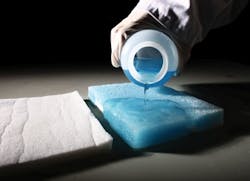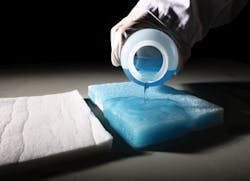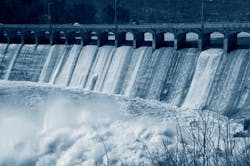Revolutionary Water-blocking Technology
With a worldwide market worth in excess of US$3 billion in 2009 – according to Industrial Fabrics Association International - geotextiles is a growing sector. Global demand is being driven by increased spending on developing infrastructure, construction projects and environmental protection. This is an exciting prospect for manufacturers who work within this field including Super Absorbent Fibre (SAF) manufacturer Technical Absorbents.
Geotextiles are traditionally permeable fabrics – which when used in conjunction with soil – have the ability to separate, filter, reinforce, protect and/or drain when used in conjunction with the soil. They are normally sheets of materials supplied in roll form, making them easier to use for small and large-scale applications.
"However, for developments that require waterproofing – landfill sites, reservoirs, dams, and other large scale civil engineering projects – it is essential for the geotextile to act as a barrier and be impermeable to liquids/gases," explains business development manager Dave Hill. "To achieve this, a super absorbent technology can be introduced during the product manufacturing process. Due to its ease of conversion, blending and bonding, SAF® is one of the preferred options and gives rise to geotextiles that can be used as alternatives to more traditional water-blocking solutions."
SAF® is white, odourless and has the appearance and handling characteristics of a textile fibre, while offering the possibility of being used to produce a wide range of fabrics and yarns. It can also be produced in a wide range of absorbency grades, staple lengths and dtex to suit different requirements.
"A waterproof barrier works in a number of ways," adds Hill. "It prevents water from seeping upwards, e.g. through cracks in an old road onto a new surface. It also stops or helps avoid the downward movement of water, water run-off and seepage.
"SAF® -based waterproofing fabrics function by initially absorbing water so that they swell. At a certain point this becomes an impermeable barrier to water. In addition, such linings avert the contamination of surrounding soils. This is particularly important in the construction of landfill sites."
The business development manager concludes: "SAF® is an extremely effective and versatile super absorbent technology. It has been developed to provide extremely high rates of saline and water uptake. Furthermore, as a fibrous superabsorbent, it allows for ease of handling and gives rise to exceptionally substantive and even distribution profiles within final fabric construction. These benefits have made it the super absorbent of choice for many customers, including those within the geotextile sector." www.techabsorbents.com


